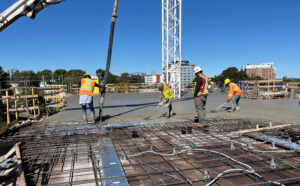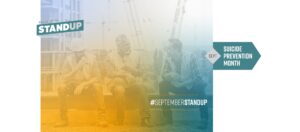News Release: End of daylight savings time poses safety hazard for construction workers
Nov. 2, 2022
Follow these 7 safety tips to reduce incidents
DARTMOUTH, NS — While most people will be ecstatic to have another hour of sleep on Sunday, Nov. 6, the end of daylight savings time can pose a significant hazard for construction sector employers.
With the benefit of an extra hour of light for morning work comes the downside of darkness arriving earlier in the evening. The sun will be setting around the same time as rush hour, which is problematic for road workers or any individuals working near a road.
According to the National Road Safety Foundation (NRSF) in the United States, car accidents increase after the clocks fall back an hour. The foundation points to a lack of visibility as well as darkness causing driver fatigue as contributing to the uptick.
SAFETY TIPS
Construction Safety Nova Scotia offers the following safety tips for industry employers.
Wear reflective gear: Ensure all your workers have proper reflective clothing and add additional reflectors or reflective tape if needed.
Ensure proper work site lighting: Having the right lighting on a construction site is always important, but it becomes even more crucial when there is less natural light in the environment. Make sure you have a reliable source of lighting so workers can see their task at hand.
Ensure sufficient personal lighting: Make sure workers have flashlights, headlamps, pen lights, or whatever they need to see the intricacies of the work they are performing.
Have a winter emergency kit: The workplace should have a winter emergency kit handy and each work vehicle should be equipped with an emergency vehicle kit. Take the time to make sure both are well-stocked and ready for winter.
Book your appointment for winter tires: If you haven’t done it already, now is a good time to book your appointment to swap your fleet’s all-seasons for snow tires. Manufacturers generally recommend changing over when the temperature is consistently below 7 C.
Snow tires go a long way in improving traction and shortening braking distance, making driving much safer. Encourage workers to make the switch on their personal vehicles as well. Include snowbrush as well. Mornings are getting frosty and visibility is reduced if not prepared. Does the road look wet? If you can’t see water coming off the tires on the car in front of you, there’s good chances the road is frozen.
Practice good housekeeping before it gets dark: You don’t want any workers slipping or tripping on whatever might be laying around the site. Take some extra time before the sun starts going down to tidy up and remove any hazards.
Toolbox talk: Supervisors should prep their workers for the upcoming time change by relaying these tips for the workplace but also relating them to their home life as well. It’s a great time to be reminded to wear a reflector on your jacket when walking the dog, check around your house for hazards that you or the kids could trip on when coming home in the dark, and make sure your second car is equipped with a vehicle emergency kit too.
For more safety tips, posters, toolbox talks, safe work practices, and customizable safety program templates, visit https://constructionsafetyns.ca/.
ABOUT CONSTRUCTION SAFETY NOVA SCOTIA
Construction Safety Nova Scotia (CSNS) is an industry funded not-for-profit association focused on improving occupational health and safety in the construction sector. All companies with a current WCB account under the construction industry classification codes 4011-4499 and 3551 are automatically members of the association due to the levies they pay to the WCB. CSNS is a highly regarded leader in occupational health and safety (OHS) services with over 300,000 students trained in health and safety and over 1,150 firms attaining the association’s COR Safety Certification. Members receive subsidized training and access to free mentorship for all aspects of their OHS programs. The board of directors, trainers, OHS advisors, and CSNS staff work towards a safer construction industry by engaging with its membership to reduce injuries and improve safety culture. https://constructionsafetyns.ca/
In the wake of Hurricane Fiona, many of Construction Safety Nova Scotia’s members are involved in restoration work across the province. Please review the following health and safety tips to ensure you are completing this important work safely and not causing long-term damage to your health.
• Conduct thorough hazard assessments on your work activities.
• Ensure frequent workplace inspections are completed as the work environment can change.
• Ensure employees and supervisors are appropriately trained to deal with the specific hazards associated with water damaged buildings.
• Be careful around water as it may be contaminated with water borne bacteria from standing water of sewer water.
• Mould is very common in water damaged properties. Use caution when handling materials containing mould. Even after water is no longer present. Pay attention to absorbent materials (cardboard, drywall, wood, insulation, ceiling tiles, carpets etc.)
• Be prepared with proper PPE, including long pants, sleeves, rubber boots and appropriate gloves and protective eyewear. Appropriate respiratory equipment may also be required.
• Be aware of possible structural damage. A home’s foundation could weaken due to flooding.
• Electrical hazards: With the potential of standing water in the property, ensure proper inspection of power tools and extension cords. If you identify damage to the property’s electrical system, contact an electrician.
• Asbestos containing materials may be present. Take consideration when working in older properties.
• Proper hygiene: practice good hygiene when working in a potentially contaminated work environment.
• Use proper lifting techniques and many of a property’s contents may need to be removed to repair the property.
The Occupational Health and Safety Act of Nova Scotia outlines the legislative rights of employees and precautions and duties of all workplace parties. It is important to recognize that “health and safety” applies to both the physical and psychological elements of the terms. This understanding can help us reframe how we apply the legislation.
Based on this understanding, reconsider the following:
- All workplace parties share the responsibility for the health and safety of persons at or near the workplace.
- Where five or more persons are regularly employed, the employer must develop a written occupational health and safety policy in consultation with the appropriate workplace parties.
- Where 20 or more persons are regularly employed, the employer must develop and maintain a written occupational health and safety program in consultation with the appropriate workplace parties that is best adapted to the circumstances of the organization for the purpose of the implementing the policy.
Every employer must:
- Ensure the safety of those at or near the workplace.
- Provide information and training necessary to protect the health or safety of employees.
- Ensure employees are aware of any health or safety hazards at the workplace.
- Carry out business in a way that does not endanger the health or safety of employees.
- Consult and cooperate with the joint occupational health and safety committee or representative.
- Establish an occupational health and safety policy and program where one is required.
Every employee, while at work, must:
- Cooperate with the employer and fellow employees to take every reasonable precaution to protect the health and safety of them‐ selves and others at or near the workplace.
- Consult and cooperate with the joint occupational health and safety committee or safety representative.
- Report unsafe acts and conditions at the workplace
An EAP, or Employee Assistance Program, is a confidential, short term, counselling service for employees with personal difficulties that affect their work performance. These difficulties, however, do not have to be caused by workplace issues. Employee Assistance Programs are designed to help people understand or overcome their difficulties regardless of whether the source is work or otherwise.
The range of areas typically managed by an EAP provider include:
- Personal difficulties.
- Job stress.
- Relationship difficulties.
- Eldercare, childcare, parenting difficulties.
- Harassment.
- Substance abuse.
- Separation and loss.
- Balancing work and family.
- Financial.
- Legal.
- Family violence.
If you are an employee, you can ask your HR representative if an EAP is available. If you are an employer wondering how to provide an EAP to workers, you can visit this
Fact Sheet.
Psychological safety is defined as the absence of harm and/or threat of harm to mental well-being that an employee might experience.
Psychologically healthy and safe workplaces and organizational culture – How are they related?
A psychologically healthy and safe workplace is one that promotes workers’ psychological well-being and actively works to prevent harm to employee psychological health including in negligent, reckless, or intentional ways. This type of workplace ensures that the basic needs of employees are considered and enhanced. These needs as it relates to the workplace include:
- Physical and psychological safety.
- Skill engagement and healthy challenge.
- Freedom to express views and contribute meaningfully to work activities.
- Reward and recognition for contributions.
- Opportunity for growth and development.
- Mutual respect from management and coworkers.
- Ample support and resources to do the job.
A psychologically unhealthy and unsafe workplace is one that lacks several or all these elements and is sustained due to unrealistic or unclear expectations, poor communication and leadership styles, lack of respect and understanding, unresolved safety concerns, insufficient breaks or time-off, and lack of recognition and opportunity for contribution or professional growth.
Organizational culture describes a pattern of basic assumptions invented, discovered, or developed by a given group that are a mix of values, beliefs, meanings, and expectations that group members hold in common and use as behavioral and problem-solving cues. The goal is to have a workplace where:
- All people are held accountable for their actions.
- All people show sincere respect for others’ ideas, values, and beliefs.
- Difficult situations are addressed effectively and appropriately.
- Workers feel they are part of a community at work.
- Workers and management trust one another.
A positive organizational culture could improve teamwork and morale, increase attendance, productivity, and efficiency, and enhance retention and competency of the workforce. A negative organizational culture could increase absenteeism and presenteeism, encourage unhealthy habits and attitudes, and create a higher risk of mental and physical problems, incidents, and accidents.
Organizational culture directly influences the level of psychological health and safety in the workplace – thus, prioritizing and working towards a positive organizational culture is key in creating and maintaining a psychologically healthy and safe workplace – and vice versa.
CSA Z1003-13 “Psychological health and safety in the workplace – prevention, promotion, and guidance to staged implementation”
Does your workplace health and safety program address mental health and psychological safety? Which existing elements of your pro‐ gram could be strengthened by considering these aspects? Have you ever wondered what gaps should be addressed to help increase the level of psychological safety in your workplace?
CSA standard Z1003-13 is a free, voluntary standard commissioned by the Mental Health Commission of Canada. The standard provides guidance for implementation and continuous improvement of a successful psychological health and safety management system. It is complete with sample documents to help you through the process.
Access the CSA standard today to help guide change in the workplace.

Return to work, mental health top of mind for Bedford-based company
At rcs construction in Bedford, being 100 percent hard hats is not enough — they’re 100 percent glasses too.
“Safety glasses may not always be a legislative requirement, but we feel they are just as important as hard hats,” said Ashley Tingley, safety manager at rcs construction.
To get buy in from employees around PPE and other safety initiatives, the safety team finds ways to make safety fun such as giving out prizes, having pizza parties and BBQs, and setting up some friendly competition during NAOSH Week.
“There’s incentive there which is great. They really get the subs engaged,” Tingley said.
Safety culture
Safety at rcs is protective rather than reactive. For example, the safety team regularly gets calls from staff asking for assistance on a critical task they have coming up.
“They will call me and say ‘Hey Ash, we have this task coming up next week. We have X, Y, Z in place. Can you think of anything else we need?’” Tingley explained. “I love getting those calls! It brings a smile to my face.”
All employees have a safety section on their yearly performance reviews, which helps keep OHS top of mind no matter the role. Additionally, all new hires are asked safety related questions during the interview process. In fact, it’s one of the first questions they’re asked.
“Because at the end of the day, it’s important for them to go home safe to their families but they also have to worry about all our subcontractors, suppliers, consultants, and clients going on site, so it needs to be a high priority,” said Andrew Doucet, director of construction. “It doesn’t matter if you’ve built 10 multi-story buildings and a bunch of base buildings and can do work in every different sector — it’s important that you understand the importance of safety so that we can all go home every day and then go to the next job.”
Safety culture starts from the top down, and rcs senior leadership is 100 percent supportive of the safety team. They step in when they need to and they are always willing to give Tingley and her team the tools and resources they need to keep the workforce safe.
Return to work
Managing the return to work process when a worker is unfortunately injured on the job hits close to home for Tingley.
“When I was in school for safety, my brother was injured on a job site and he suffered from a brain injury and I watched that process from a personal standpoint — just not getting the support he needed — and I vowed to myself if anyone was ever injured at rcs, I would be there and be that support,” she said.
With this in mind, the safety team likes to be involved in return to work right from the beginning, and they maintain constantly communication with the employee while they are off work. While they want workers to come back as soon as they can, the rcs safety team wants to see them back to their pre-injury role and fully recovered. If that’s not possible, they will explore light-duty options. The company works with CBI Health and has been very happy with the service they provide to help the injured worker throughout this process.
Mental health
Doucet is a vice-chair of the Mental Health Association of Nova Scotia, so ensuring rcs workers’ mental health is taken care of is of the utmost important to him. The company offers an employee and family assistance program, and in 2021 partnered with Enriched Academy, which teaches financial literacy — a huge factor in mental wellness for individuals.
“Whether it’s you or a family member struggling with mental health, you’re going to come to work and you won’t be as focused and that all ties back to safety again,” he said. “If people are coming to work and their mental wellness if not in check, it’s a safety concern.”
The company also does a social post that goes to all rcs employees for “Wellness Wednesday” to offer health-related tips to its workers. The company also offers discounted gym memberships around the Halifax Regional Municipality.
The construction company is a leader in physical and psychological safety who is COR® certified and strongly prefers COR® for its subcontractors as well. The company believes in continuous improvement and it strives for safety excellence every day.
“I’ve been here almost nine years and I have watched the safety culture, grow, expand and transform,” Tingley said. “Safety is a priority for everyone that works at rcs and it’s something that they believe in.”

At Marco Group, communication and consistency are keys to safety success
Marco Group is the largest Atlantic Canadian-based general contractor. They operate in the retail, commercial, recreational, multi-residential, entertainment, health care, educational, and light industrial sectors as design-builders, construction managers, and general contractors. The company is proud to be COR® certified and it actively encourages this certification in its subcontractors.
“When we see a subcontractor is COR® certified, right away we know they have the basic elements of a program in place,“ says Patrick Mills, safety manager for Marco’s Dartmouth office.”[We know that] a third party has come to them and said ‘Yes, you have a policy and you have safe work practices and job procedures.’ We know their program has been vetted.”
The culture of safety at the company is very strong, Mills notes. This is especially apparent in the commitment shown by their superintendents.
“[Our superintendents] have the greatest span of control on our sites. They are the ones having the conversations with the trades, and they know really what is going on,” he says. “They have a safety background and field experience — they’ve seen a few things — and they can have conversations in the field about safety and relate to the subcontractors’ experiences. If they see a hazardous situation they immediately take the subcontractor aside and tell them why it could cause problems.”
Marco’s newer superintendents are mentored by the more experienced individuals, so they learn how to establish a positive safety culture and outline their expectations to the subcontractors. This ensures the program is consistently enforced on all project sites.
Speaking Up
Marco encourages workers on their sites to speak up and report hazards when they encounter them.
“We want people to speak up if they notice a potential hazard” says Mills. ”The more people are comfortable stepping forward, the more hazards will be reported. This helps make everyone aware of potential risks and their controls, and we all learn from it,” explains Mills.
With this in mind, each quarter the company recognizes an individual on each job site that has demonstrated an exceptional attention to safety. “Positive reinforcement has proven to be effective,” says Mills, “and its also good for morale. It benefits everyone in the long run.”
Marco’s commitment to creating a respectful workplace also enhances site safety.
“A respectful tone encourages people to have more open conversations and encourages safety. I do think they go hand in hand,” Mills says. “The more respectful things are, the more willing people will be to help each other out on site.”
Mental Health
Marco goes beyond industry standards to prioritize mental health in the workplace.
Employees and their families have access to an Employee and Family Assistance program and an annual benefits allotment for psychology and counselling services in the amount of $1,000.
The company also has a wellness program that allows employees to connect with health professionals that provide can training and resources customized to each employee’s needs to improve their physical and mental wellbeing. Marco also supports mental health first aid training to ensure our teams have the tools to manage a mental health crisis should one arise on a project site.
“Mental health is definitely a contributor to accidents,” says Mills. It might not be captured in the incident investigation as a root cause, but it can definitely be a contributing factor. Knowing we have access to mental health support if we need it, is a massive benefit to everyone on our team.”
Leadership Commitment
The leadership at Marco is very involved in safety. Corey Taylor, Marco’s senior vice-president of operations, is involved in safety meetings and makes frequent site visits. Mills notes that the involvement of senior management has been a key element of Marco’s safety success.
“[Corey] is constantly making observations himself. In other organizations, management may not be as involved, but when you have a manager who is going out to the job sites and seeing the work being done, and who knows right from wrong in the safety world, it’s highly beneficial to everyone,” he says.
Marco’s focus on communication and consistency is clearly paying off. The company is a three-time winner of Construction Safety Nova Scotia’s Safety Champion Award and the ongoing Corner Brook Acute Care Hospital in Newfoundland has reached over 2,000,000 worker hours without a lost-time injury.
“We continually look for ways to improve our safety program,” says Mills, “and we are proud to see everyone go home safely at the end of the day.”
VIRTUAL CONFLICT RESOLUTION – Nov. 16 (click to register)
Associate Members Plus – $103
Associate Member – $155
Are you a member? Find out here.

Sept. 21, 2022 — Construction Safety Nova Scotia CEO MJ MacDonald and was interviewed by Global TV News at 6 Halifax about the very important — and often overlooked — topic of suicide in the construction sector.
Watch here!
Do you need resources for suicide prevention or mental health in general on your construction site? Check out posters, toolbox talks, and more here.
September 13th, 2022
Construction industry has high suicide rate, according to CDC, but CSNS has resources available to help

DARMOUTH, NS — Male construction workers have a 65 percent higher suicide rate than male workers in all other sectors, according to a report from the U.S. Centers for Disease Control and Prevention (CDC). September is Suicide Prevention Month, and Construction Safety Nova Scotia is urging its members to focus on mental health on the job site.
“Mental health and psychological safety is just as important as physical safety on the job site,” said MJ MacDonald, CEO of Construction Safety Nova Scotia. “We want to shine a light on Suicide Prevention Month and make sure our members know it’s important to look for signs in your workers. But you’re not in this alone – there’s many resources available for how you can support them if they are at risk.”
Construction Safety Nova Scotia has several resources available on its website to support construction sector employers broach the difficult topic of suicide in the workplace:
- Four toolbox talks on warning signs, how to talk about suicide, the risk of suicide in construction, and making mental health a priority
- Suicide prevention posters
- Needs analysis and implementation tool
According to the CDC report, a high-pressure work environment, working in remote locations, and a “tough guy” mentality all contribute to high suicide rates in the construction sector. To that end, mental health in general needs to be a focus for construction sector employers.
“There’s much to be done to get workers comfortable speaking up about mental health, but take a slow and steady approach: Discuss it during toolbox talks, show some mental health videos, and don’t be afraid to mention your own mental state if you’re having a difficult day yourself,” said MacDonald.
CSNS has resources specifically for employers and employees on its website, as well as many mental health videos.
Image and suicide resources courtesy of the Construction Industry Alliance for Suicide Prevention.
ABOUT CONSTRUCTION SAFETY NOVA SCOTIA
Construction Safety Nova Scotia (CSNS) is an industry funded not-for-profit association focused on improving occupational health and safety in the construction sector. All companies with a current WCB account under the construction industry classification codes 4011-4499 and 3551 are automatically members of the association due to the levies they pay to the WCB. CSNS is a highly regarded leader in occupational health and safety (OHS) services with over 300,000 students trained in health and safety and over 1,150 firms attaining the association’s COR Safety Certification. Members receive subsidized training and access to free mentorship for all aspects of their OHS programs. The board of directors, trainers, OHS advisors, and CSNS staff work towards a safer construction industry by engaging with its membership to reduce injuries and improve safety culture. https://constructionsafetyns.ca/







